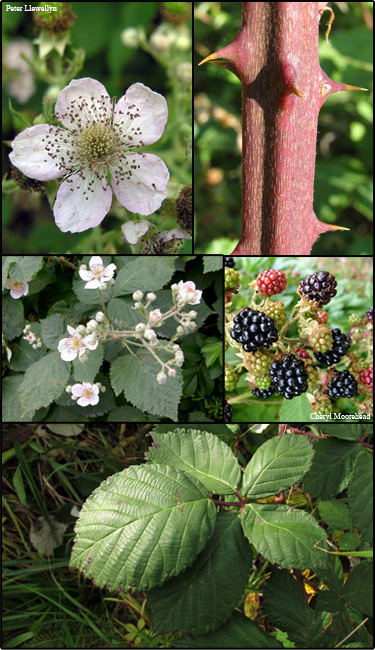Himalayan blackberry (Rubus armeniacus)
 Synonyms: Rubus bifrons
Synonyms: Rubus bifronsDescription: It was introduced to North America in 1885 as a cultivated crop.
Habit: Erect, spreading, or trailing evergreen shrub that gets very large and grows in dense, impenetrable thickets.
Leaves: Palmately compound, usually with 5 leaflets, but sometimes 3 on younger growth. Leaflets are unequally, coarsely toothed, and round to braodly oblong with an abrupt tip at the apex. Green above with white-felt or silverish hue underneath. Undersides of leaf margins have a row of thorns.
Stems: Erect and arching, tips root when they come in contact with the soil. Reddish in color and strongly angular with large, hooked thorns. Mature canes are glabrous and die back each year but remain standing through winter.
Flowers: White to pinkish in color, 5 petals with numerous stamens, and borne in large terminal clusters.
Fruit and seeds: Fruits are dry and red when immature, turning to large, shiny berries, deep purple to black when mature in fall. Fruits are edible. Berries persist into winter.
Habitat: Native to western Europe. Found in areas of full sun but is also shade tolerant, flooding and drought resistant, and adaptable to a variety of open and wooded habitats, wetlands, riparian areas, old fields and disturbed sites.
Reproduction: By seed, vegetatively through rhizomes, and by tip-rooting (tips of canes root upon contact with ground).
Similar species: Common high-bush blackberry (Rubus allegheniensis).
Monitoring and rapid response: Dig out plants with a shovel, making sure to remove entire root mass. Mowing is effective but will not kill plants. Cover infested areas with black landscape fabric for at least 2 growing seasons. Apply foliar spray with glyphosate in fall and use selective broadleaf herbicides in open areas. Credits: The information provided in this factsheet was gathered from the Wisconsin Department of Natural Resources, the California Invasive Plant Council and Virginia Tech Department of Forest Resources and Environmental Conservation.
Individual species images that appear with a number in a black box are courtesy of the Bugwood.org network (http://www.invasive.org).Individual photo author credits may not be included due to the small display size of the images and subsequent difficulty of reading the provided text. All other images appear courtesy of Google (http://images.google.com).
